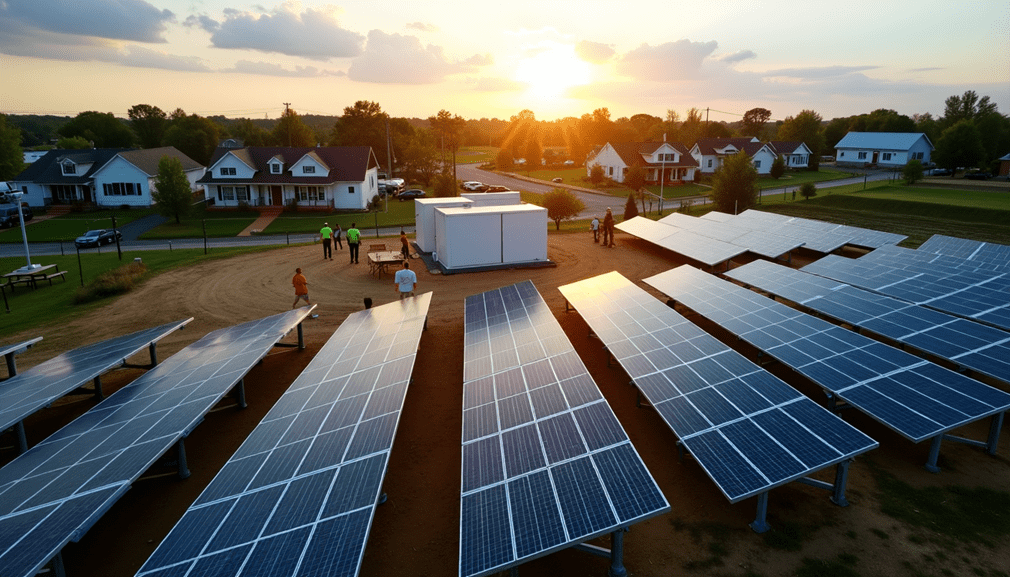Solar microgrids are changing the way communities access and manage their power. These systems help local communities cut their energy costs by up to 60%. The cost reduction becomes especially important as more regions look for green, reliable energy solutions.
Rural electric cooperatives serve over 42 million Americans and cover 60% of America’s landmass. These cooperatives now embrace these groundbreaking systems more than ever. Colorado’s Holy Cross Energy achieved 50% renewable power generation, while Kenya’s solar microgrids now provide reliable electricity to over 3,000 people.
Our detailed guide will show you how solar microgrids work and their potential to save costs. You’ll discover real-life community success stories and learn the steps to build a solar microgrid. We’ll also help you tackle common setup challenges to determine if this solution fits your community’s needs.
What Makes Solar Microgrids Cost-Effective
Solar microgrids offer compelling financial benefits to communities that want energy independence. Commercial and industrial microgrids cost about USD 4.00 million per MW, while community microgrids cost USD 2.10 million per MW.
Original Setup Costs vs Long-term Savings
Solar microgrids’ upfront investment pays off well over time. These systems typically give a return on investment of 6-8%. The payback period runs 3-5 years, and operating costs range from USD 0.15-0.30 per kWh – 40% lower than traditional diesel alternatives.
60% Cost Reduction: Breaking Down the Numbers
Three main factors drive this dramatic cost reduction. Solar panel prices have dropped to less than 20 cents per watt. Battery costs have fallen too, with lithium-ion batteries now costing below USD 200 per kWh. Modular designs and standardized components have simplified installation, and technicians can complete the setup within days.
Government Incentives and Tax Benefits
The Inflation Reduction Act (IRA) provides unprecedented financial support. Property owners can receive tax credits covering up to 70% of renewable energy project costs. The Investment Tax Credit (ITC) also offers a 30% deduction through 2032. This credit percentage drops to 26% in 2033 and 22% in 2034.
Nonprofit organizations and government entities can use the “Direct Pay” option to receive payments from the federal treasury equal to the tax credit amount. The IRA has set aside USD 370 billion for climate and clean energy initiatives, making solar microgrids more available to communities.
Step-by-Step Guide to Building a Solar Microgrid
A successful solar microgrid installation demands meticulous planning and systematic execution. A detailed site assessment serves as the foundation of a successful installation.
Planning and Site Assessment
Engineers start with a full site evaluation to determine solar potential and infrastructure requirements. They review roof conditions, orientation, shading factors, and space available for equipment placement. This phase takes 1-2 weeks. During this time, experts analyze energy consumption patterns and review existing electrical infrastructure.
Equipment Selection and Sizing
System sizing calculations help determine peak load values and optimal component specifications. A solar calculator helps estimate system size in kilowatts, annual kilowatt-hour production, and financing options. The technical review focuses on:
- Power generation requirements
- Battery storage capacity needs
- Distribution infrastructure specifications
- Control system requirements
Installation Timeline
The physical installation takes 2-5 days, with phases spread across two weeks. Technicians handle equipment mounting, electrical connections, and control system setup. Local officials verify safety standards and code compliance through final inspections. The whole ordeal, from the original consultation to system activation, typically spans 6-18 weeks.
Qualified vendors handle permit acquisition and submit paperwork to local agencies. System size, structural considerations, and inspector availability affect installation complexity. The microgrid needs regular maintenance and quality checks to perform at its best.
Real Cost Savings from 5 Community Projects
Real-world solar microgrid implementations in various communities show significant financial advantages. These projects highlight both short—and long-term cost benefits.
Rural Colorado: $2.5M Saved in 3 Years
Colorado’s Department of Local Affairs (DOLA) provided grants exceeding $2 million to enhance the state’s electric grid. Rural and mountain communities, which face higher energy costs, were the primary focus. Solar microgrid implementation in these regions generated $2.5 million in savings within three years.
California School District Success Story
Chula Vista Elementary School District’s solar microgrid project stands as a remarkable achievement. The district’s 8.1 MW solar microgrid system has:
- 18,050 solar panels that provide shade to school buildings
- Battery storage systems to manage peak hours
- Transportation yard and support center coverage
The district funded this project through a $32 million general obligation bond and expects to save $70 million over 25 years. The system now meets 90% of the district’s energy needs. Santa Barbara Unified School District achieved comparable results by installing solar microgrids at six school sites. These installations operate under a 28-year power purchase agreement and should deliver a total savings of $7.8 million.
Microgrid systems work best during peak hours and reduce energy consumption from traditional electric grids when costs are highest. This smart energy management approach led to an 18% reduction in total electricity expenses from 2023 to 2022.
Common Setup Challenges and Solutions
Solar microgrid setups present unique challenges that require smart solutions. However, communities can better prepare when they understand these obstacles.
Funding Hurdles
Many communities are prevented from moving forward because of their original capital costs. Instead of direct purchases, communities are now exploring various financing options. Energy-as-a-Service (EaaS) models allow organizations to shift from capital expenses to operational costs. Before taking the next step, communities should consider federal grants, including FEMA’s Hazard Mitigation Grant Program.
Technical Issues
Because of their complexity, microgrid systems require specialized expertise. State-level regulatory differences create more complications that affect interconnection requirements and utility tariffs. Until standardized designs become common, each project will need custom solutions for equipment integration and control systems.
Community Buy-in Strategies
Smart planning helps address the “Not In My Backyard” (NIMBY) phenomenon. Successful community involvement includes:
- You retain control through complete transparency about project details and timelines
- Creating opportunities for community voices through workshops and surveys
- Implementing “Payments In Lieu Of Taxes” (PILOT) programs to invest in local amenities
- Handling concerns about agricultural land use and visual effect
Eco-friendly business models support long-term success. These models typically include tiered pricing structures and maintenance funds from operational revenues. Communities can guide these challenges while maximizing their solar microgrid investment benefits through proper planning and stakeholder involvement.
Conclusion
Solar microgrids help communities reduce costs and gain energy independence. Success stories from all over the United States show that these systems work exceptionally well. Thanks to cheaper components and strong government backing, communities can slash their energy costs by 60% and still have reliable power.
The benefits show up clearly on the ground. Rural communities in Colorado saved $2.5 million in just three years. California’s school districts expect to save $70 million over 25 years. These wins come from good planning, smart implementation, and making the most of available incentives. The Investment Tax Credit offers 30% deductions until 2032.
Setting up these systems can be tricky, especially when funding issues and technical complexities arise. However, communities find ways forward through financing options and expert help. Energy-as-a-Service models, federal grants, and community participation strategies help tackle these challenges.
Solar microgrids do more than save money. They allow communities to manage their energy sustainably. Their success stories show how local action creates lasting change that benefits current and future generations.





